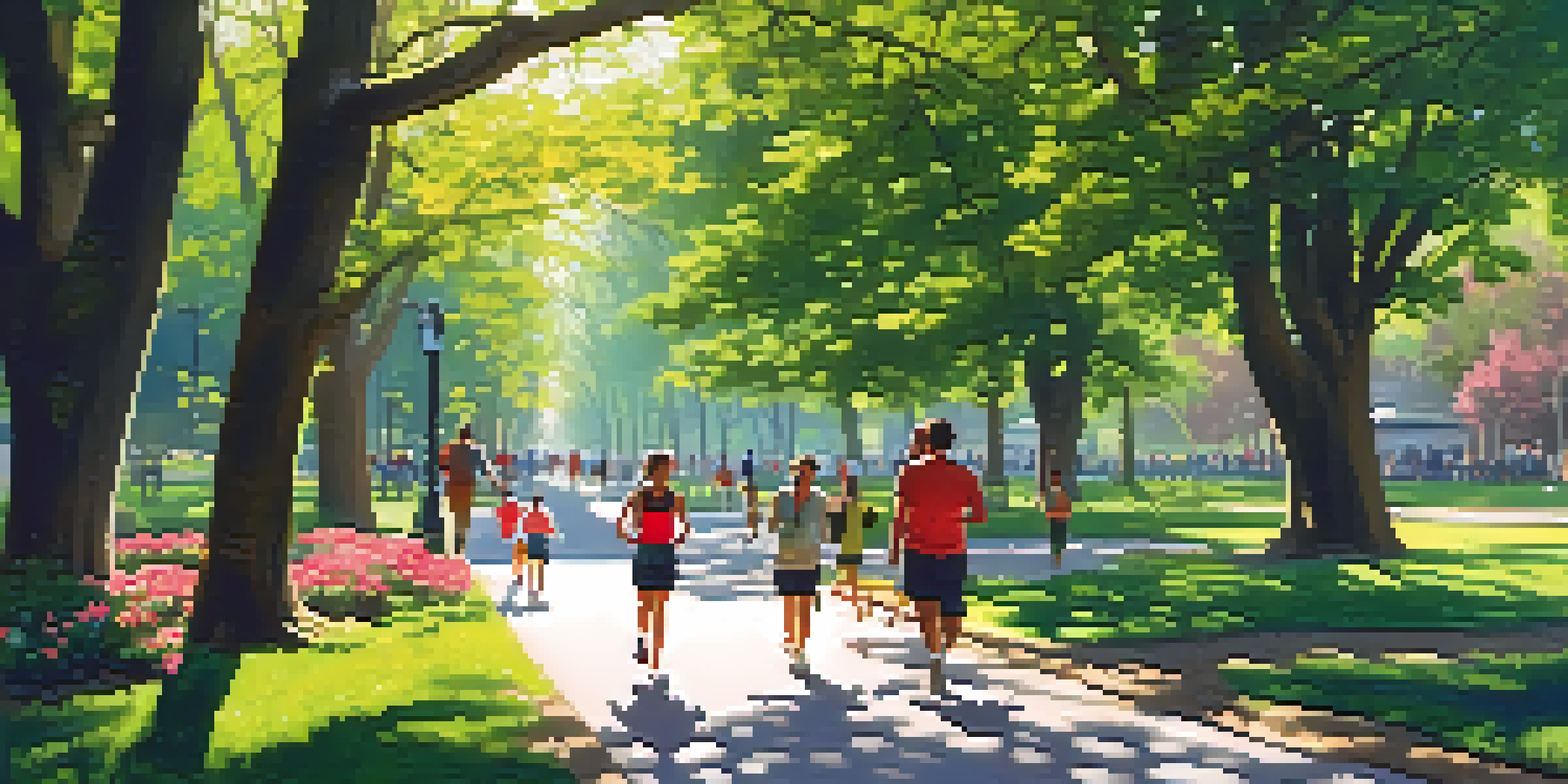The Importance of Trees in Urban Ecosystems and Biodiversity

Trees as Essential Components of Urban Ecosystems
Trees play a crucial role in urban ecosystems, acting as the lungs of our cities. They absorb carbon dioxide and produce oxygen, improving air quality significantly. Without trees, urban areas would struggle with higher pollution levels and reduced air freshness, impacting residents' health and well-being.
The best time to plant a tree was twenty years ago. The second best time is now.
Moreover, trees provide shade, helping to cool city streets and reduce the urban heat island effect. This is particularly important during hot summer months when temperatures can soar. By keeping our cities cooler, trees not only enhance comfort but also reduce energy consumption in buildings, leading to lower electricity bills.
In addition to their cooling effects, trees contribute to stormwater management by absorbing rainwater and reducing runoff. This helps prevent flooding and minimizes the burden on urban drainage systems. In essence, trees serve as natural sponges, helping our cities manage water more effectively.
Enhancing Urban Biodiversity Through Trees
Urban areas often struggle with biodiversity loss, but trees can help restore it. They provide habitats for various species, including birds, insects, and small mammals, creating a vibrant ecosystem within the concrete jungle. Planting trees in cities can turn a barren landscape into a thriving habitat for wildlife.

For example, a single tree can host a multitude of creatures, from caterpillars munching on leaves to birds nesting in its branches. This intricate web of life contributes to the overall health of urban ecosystems, making cities more resilient to environmental changes. The presence of diverse species also enhances the aesthetic and recreational value of urban spaces.
Trees Improve Urban Air Quality
Trees act as natural air filters, absorbing pollutants and enhancing the overall air quality in urban areas.
By planting native trees, we can further encourage local wildlife to thrive. Native species are adapted to the local environment and provide the specific resources that local animals need. This approach not only supports biodiversity but also fosters a deeper connection between urban dwellers and their natural surroundings.
Improving Mental Health and Well-Being with Trees
The presence of trees in urban settings has a profound impact on mental health. Studies show that green spaces reduce stress levels and promote feelings of relaxation and happiness. Simply walking through a park filled with trees can elevate mood and provide a sense of peace amid the hustle and bustle of city life.
Trees are the earth’s endless effort to speak to the listening heaven.
Trees also encourage outdoor activities, such as walking, jogging, or picnicking, which contribute to physical health. When people engage more with nature, they tend to feel more connected to their communities and experience a greater sense of belonging. This connection can be incredibly beneficial for overall well-being.
Moreover, community engagement in tree planting initiatives fosters social bonds among residents. Working together on local green projects can strengthen relationships and create a sense of pride and ownership within neighborhoods. Trees, therefore, not only beautify our surroundings but also enhance community ties.
Trees as Natural Air Filters in Urban Areas
One of the most remarkable benefits of trees is their ability to filter air pollutants. They capture dust, smoke, and other particulate matter, effectively cleaning the air we breathe. This is especially vital in urban areas, where traffic and industrial activities contribute to poor air quality.
Through a process called photosynthesis, trees absorb harmful gases such as sulfur dioxide and nitrogen dioxide, further purifying the air. This natural filtration system plays a significant role in reducing respiratory issues and promoting healthier lifestyles for city dwellers. It's a win-win for both people and the planet.
Trees Boost Mental Health Benefits
The presence of trees in urban spaces promotes relaxation and encourages outdoor activities, positively impacting mental well-being.
In fact, studies have shown that areas with higher tree cover often experience lower rates of asthma and other respiratory diseases. By investing in urban forestry, cities can significantly improve public health outcomes. Trees truly are nature's air purifiers, making urban living more sustainable and enjoyable.
Combatting Climate Change with Urban Trees
Trees are powerful allies in the fight against climate change. They sequester carbon dioxide, one of the main greenhouse gases responsible for global warming. By absorbing CO2, trees help mitigate climate change effects, making urban areas more resilient to its impacts.
In addition to carbon sequestration, trees can help regulate temperatures, reducing the need for air conditioning in summer months. This not only lowers energy consumption but also reduces greenhouse gas emissions from power plants. Therefore, planting more trees can be an effective strategy for cities aiming to reduce their carbon footprint.
Furthermore, trees contribute to biodiversity and ecological stability, which are essential for coping with climate-related challenges. By preserving and increasing tree cover in urban areas, cities can create a more sustainable future. Investing in trees is investing in a healthier planet for generations to come.
Economic Benefits of Urban Trees
Urban trees don't just provide environmental benefits; they also offer significant economic advantages. Properties located near trees and green spaces tend to have higher property values, attracting potential buyers and renters. This can lead to increased tax revenues for local governments, benefiting the community as a whole.
Moreover, trees can reduce energy costs for residents by providing shade and cooling effects. This translates to savings on air conditioning during hot summer months, allowing families to allocate their budgets elsewhere. Healthy urban forests can also decrease stormwater management costs, as trees absorb rainwater and lessen the burden on drainage systems.
Economic Gains from Urban Trees
Urban trees increase property values, reduce energy costs, and attract visitors, contributing to vibrant local economies.
Additionally, the presence of trees can boost local businesses by creating appealing environments that attract visitors. People are more likely to spend time in areas with greenery, leading to increased foot traffic and sales for local shops. Trees, therefore, contribute to vibrant, economically thriving communities.
Creating Sustainable Urban Landscapes with Trees
The integration of trees into urban planning is essential for creating sustainable cities. By incorporating green spaces, planners can enhance the quality of life for residents while addressing environmental challenges. Trees should be viewed as integral components of urban design rather than mere decorative elements.
Sustainable urban landscapes prioritize biodiversity and ecosystem services, ensuring that cities remain livable for future generations. This involves selecting the right tree species, considering factors such as climate resilience, growth patterns, and ecological compatibility. Thoughtful planning can lead to diverse, thriving urban forests that benefit both people and wildlife.

Moreover, community involvement in tree planting and maintenance fosters a sense of stewardship. Engaging residents in the care of their local trees can lead to stronger community bonds and a shared commitment to sustainability. Together, cities can create greener, healthier environments that resonate with their values and aspirations.